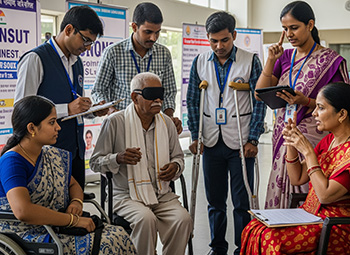Will the 2026 Census Count People with Disabilities?
11th Sep 2025
Will the 2026 Census Count People with Disabilities?The 2026 Census of India will bring crucial perception regarding the nation’s demographic realities, and an essential question is whether or not people with disabilities will be sufficiently included. For inclusive development, welfare programs, and policymaking, accurate representation is crucial. Previous censuses have been criticised for underreporting because of their narrow definitions and limited survey techniques. A more inclusive society for all would be fostered by ensuring comprehensive disability data by 2026, which would enable authorities to effectively address issues and advance equal opportunities.Why the 2026 Census Must Include People with DisabilitiesThis section will clear your doubts about why persons with disabilities in India must be included in the 2026 Census, highlighting the need for accurate representation to promote fair policies and an inclusive social structure.What Does It Mean to Count Everyone? The 2026 Census on inclusion of people with Disabilities represents the fundamental concept of counting everyone. It ensures that they receive the recognition they deserve, maintains their equal dignity, and serves as a basis for laws that promote social justice, equity, and inclusion. The Impact of Being Left Out of National DataExclusion of people with disabilities from the 2026 Census would erase their presence from national data, hindering democratic governance. Such an omission causes systematic neglect, affects policy priorities, and inappropriately allocates resources. Moreover, it restricts the basis for inclusive growth that upholds national progress and social justice, which in turn affects the accurate representation and decision-making. How Past Censuses Overlooked People with DisabilitiesPeople with disabilities were not included in previous censuses, which resulted in insufficient census disability data and restricted the development of equitable policies, resources, and practices.A Brief Look at 2011 Census Data Gaps The 2011 Census data highlighted significant data gaps regarding people with disabilities, mostly due to the limited survey mechanism and narrow definition. These flaws led to underreporting, resulting in limited efficacy of policies meant to ensure equal opportunities and inclusion. It left a substantial portion of the population unrepresented in official statistics. Why the Numbers Don't Reflect RealityDue to limited methodologies, vague definitions, and deep stigma, people with disabilities have been routinely left out of previous censuses. As a result, census data on disabilities is not accurate; the numbers understate prevalence, mask lived experiences, and ignore intersectional challenges, which distorts the scope and complex needs of this underserved group.Will the 2026 Census Include People with Disabilities?Ensuring representation, equity, and policies that reflect the realities of people with disabilities instead of their statistical invisibility is a crucial responsibility of the 2026 Census.Government Statements and Policy IntentionsA greater commitment to inclusivity is evident in government declarations and policy intentions for the 2026 Census. Authorities have placed a strong emphasis on addressing underreporting, enhancing data collection methods, and refining disability definitions. These actions represent a conscious attempt to ensure that individuals with disabilities are fairly represented in national demographic data, reflecting their actual circumstances.What’s Still Missing in the Planning ProcessDespite the efforts of the 2026 Census to include people with disabilities, there are still significant gaps. There is limited involvement of people who speak up for disability rights, a lack of standardised definitions, and inadequate accessibility measures, which run the risk of sustaining underestimation, which would leave this population's daily lives under-represented and poorly understood.Why Disability Data Matters for IndiaDisability data in India is crucial as it facilitates inclusion, fills systemic gaps, informs policy decisions, and utilises evidence-based methods to empower millions of people.Impact on Healthcare, Education, Employment & Infrastructure Accurate disability data is essential for India to improve healthcare access, encourage equitable employment, create inclusive education, and build accessible infrastructure. It permits focused policies, effective use of resources, and well-informed planning, ensuring the full participation of individuals with disabilities in society and filling in structural deficiencies in these vital areas. Data as a Tool for Empowerment and Inclusion As a tool for inclusion and empowerment, the accuracy of disability data is essential for India. It directs the development of infrastructure, assures fair access to jobs, healthcare, and education, and informs evidence-based policy. Such data facilitates targeted interventions by identifying unmet needs, promoting social participation, equal opportunities, and dignity for all people with disabilities.How Better Data Can Improve Government Schemes and Budget AllocationThe actual needs of citizens with disabilities are revealed by accurate disability data.It makes specific government programs for work, education, and healthcare possible.Identifies priority areas to enable effective budget allocation.Aids in filling in implementation gaps for policies.Encourages equitable development and inclusive growth throughout India.What Needs to Change for a Truly Inclusive 2026 CensusFor a truly inclusive census 2026, authorities must make sure that accurate data is collected, taking into account the various needs of every citizen, and using accessible survey techniques.Use of the Right Definitions and Disability FrameworksWe must use the appropriate disability definitions and frameworks, such as the Rights of Persons with Disabilities (RPwD) Act and WHO's International Classification of Functioning, Disability, and Health (ICF), to have a truly inclusive 2026 Census. By using these definitions, underreporting is prevented, accurate representation is ensured, and policies are strengthened, allowing all people with disabilities to be recognised, counted, and supported fairly and with dignity.Training Census Officials to Identify and Record Disability AccuratelyTo accurately and carefully identify and record disabilities, census officials need to undergo specialised training. It is crucial to have clear guidelines, real-world case examples, and knowledge of the various kinds of disabilities. Such training improves inclusive policy planning and resource allocation, guarantees accurate data, and lowers underreporting.Involving Disability Rights Groups in Census Planning Disability rights groups need to play a key role in the planning process for a 2026 Census that is truly inclusive. Their involvement will ensure sensitive data collection techniques, improved survey tools, and accurate representation. Collaborating with Rights of Persons with Disabilities India will close knowledge gaps, improve accountability, and ensure that the census accurately represents the varied realities of people with disabilities.Voices from the Community: What People with Disabilities Are SayingCommunity voices bring to light the actual experiences of individuals with disabilities, highlighting their demand for policies that acknowledge, accommodate, and meaningfully include them.Personal Stories of Being Left Out Many people with disabilities have experienced exclusion at some point in time. As the first female amputee to climb Everest, Arunima Sinha, whose leg was amputated following a robbery, remembers how society questioned her abilities. Kanubhai Tailor, who has polio, also recalls being shut out of public places and schools. Their experiences highlight how systemic neglect exacerbates exclusion while calling for compassion, respect, and true inclusion. What Inclusion Would Mean to Millions For millions of people with disabilities, disability inclusion in India means equal opportunity, dignity, and rights. It involves open access to work opportunities, public areas, and education, where hurdles are eliminated and opinions are valued. A society that respects diversity, ensures justice for all, and encourages self-reliance is the result of true inclusion.Conclusion: From Numbers to Visibility, Rights, and RespectIt is important to view India’s disability population as individuals who deserve respect, rights, and visibility rather than merely as statistics. Accurate data can ensure fair access to healthcare, education, and employment, improve budget allocation, and fortify policies, moving beyond mere numbers to meaningful representation. Removing barriers, elevating voices, and promoting dignity are all components of a truly inclusive approach. India can use its census as a basis for equality, justice, and empowerment for people with disabilities if it embraces inclusivity.
Read More




.png)



.png)
.png)
.png)




